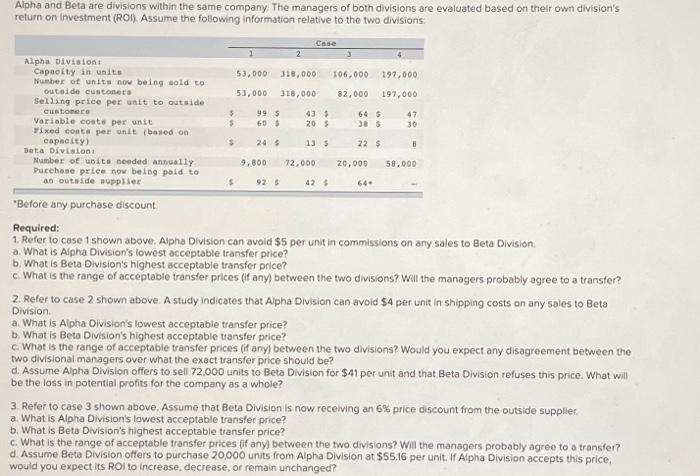Alpha and Beta are divisions within the same company. The managers of both divisions are evaluated based on their own division's return on investment (ROI). Assume the following information relative to the two divisions: Case 2 53,000 318,000 106,000 197,000 53,000 318,000 Alpha Division: Capacity in units Number of units now being sold to outside custoners Selling price per unit to outside customers Variable conte per unit Tixed coats per unit (based on capacity) Beta Division Number of units needed annually Purchase price now being paid to an outside supplier $ $ 995 605 435 20$ 82,000 197,000 645 47 38$ 30 $ 24 $ 13 5 225 9,800 72,000 20,000 58,000 925 425 64 Before any purchase discount Required: 1. Refer to case 1 shown above. Alpha Division can avold $5 per unit in commissions on any sales to Beta Division a. What is Alpha Division's lowest acceptable transfer price? b. What is Beta Division's highest acceptable transfer price? c. What is the range of acceptable transfer prices (if any) between the two divisions? Will the managers probably agree to a transfer? 2. Refer to case 2 shown above. A study indicates that Alpha Division can avoid $4 per unit in shipping costs on any sales to Beta Division a. What is Alpha Division's lowest acceptable transfer price? b. What is Beta Division's highest acceptable transfer price? c. What is the range of acceptable transfer prices (if any) between the two divisions? Would you expect any disagreement between the two divisional managers over what the exact transfer price should be? d. Assume Alpha Division offers to sell 72,000 units to Beta Division for $41 per unit and that Beta Division refuses this price. What will be the loss in potential profits for the company as a whole? 3. Refer to case 3 shown above. Assume that Beta Division is now receiving an 6% price discount from the outside supplier a. What is Alpha Division's lowest acceptable transfer price? b. What is Beta Division's highest acceptable transfer price? c. What is the range of acceptable transfer prices of any between the two divisions? Will the managers probably agree to a transfer? d. Assume Beta Division offers to purchase 20,000 units from Alpha Division at $55.16 per unit. If Alpha Division accepts this price, would you expect its ROI to increase, decrease, or remain unchanged? 3. Refer to case 3 shown above. Assume that Beta Division is now receiving an 6% price discount from the outside supplier. a. What is Alpha Division's lowest acceptable transfer price? b. What is Beta Division's highest acceptable transfer price? c. What is the range of acceptable transfer prices (if any) between the two divisions? Will the managers probably agree to a transfer? d. Assume Beta Division offers to purchase 20,000 units from Alpha Division at $55.16 per unit. If Alpha Division accepts this price, would you expect its ROI to increase, decrease, or remain unchanged? 4. Refer to case 4 shown above. Assume that Beta Division wants Alpha Division to provide it with 58,000 units of a different product from the one Alpha Division is producing now. The new product would require $25 per unit in variable costs and would require that Alpha Division cut back production of its present product by 29,000 units annually. What is Alpha Division's lowest acceptable transfer price








